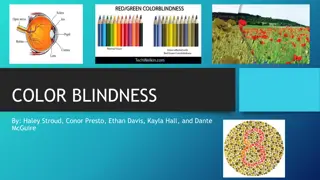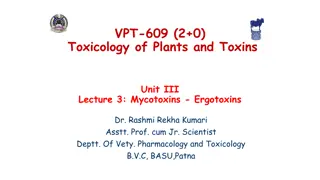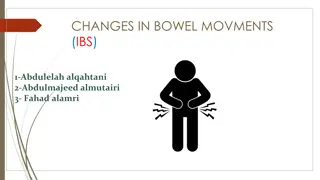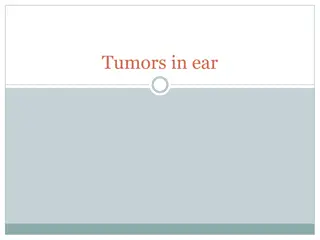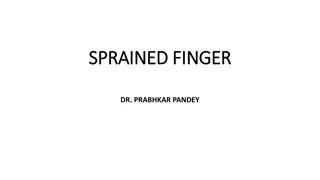Understanding Gangrene: Causes, Types, and Symptoms
Gangrene is a severe condition characterized by tissue necrosis, often due to loss of blood supply or bacterial infections. It is classified into dry, moist, and gas gangrene based on various factors like blood supply and fluid loss. Dry gangrene, also known as mummification, typically affects extremities and can be caused by vascular obstructions or extreme cold. The condition progresses slowly, leading to tissue death and eventual mummification. Senile gangrene specifically affects older individuals with narrowed arteries, resulting in dry gangrene of the lower limbs. Timely intervention is crucial to prevent further complications in gangrene cases.
Download Presentation

Please find below an Image/Link to download the presentation.
The content on the website is provided AS IS for your information and personal use only. It may not be sold, licensed, or shared on other websites without obtaining consent from the author. Download presentation by click this link. If you encounter any issues during the download, it is possible that the publisher has removed the file from their server.
E N D
Presentation Transcript
Gangrene Dr Versha Prasad
Gangrene Gangrene is a form of necrosis of trissuue with superadded putification. Gangrene is usually divided into dry ,moist and gas gangrene. The condition which determines the type depends on: a) Blood supply to the part and b) Fluid loss from the part by draining and evaporation c) Gas gangrene is due to infection with specific organisms
Causes and type of Gangrene Causes of Gangrene: Two main causes of gangrene are : - Loss of Blood Supply - Bacterial Infections Types Of Gangrene: a) Dry Gangrene b) Wet/ Moist Gangrene c) Gas Gangrene
Dry Gangrene ( Mummifications) This term is usually applied to infarction causing massive death of a portion of the extremity with simole mummification of the part as a result of evaporation of water. Cuses of Dry Gangrene: a) Gradual Vascular Obstruction: Seen in Diabetic Gangrene. Thromboangitis Obliterence Raynaud s Disesase b) Sudden Vascular Occlusion: As in Embolism, Thrombosis, Ligation or injury to vessel. c) Extreme Cold: Producing frost BiteThis act in two ways I. By causing extreme contraction of the small arteries and the tissues dies II. Direct action of cold on the tissues
Dry Gangrene Dry gangrene is typically seen , when the arteries of the lower extremities are blocked at the distal portion particularly in the senile condition as a result of arteriosclerosis, without establismentof collateral circulation of the part . The effected part becomes dried shriveled and mummified greenish yellow and finally drak brown or black in colour. The gangrene spreads slowly upwards until it reaches a point where there blood supply is adequate to keep the tissue viable. There is a line of demarcation between necrosis and healthy tissue.
Dry Gangrene Senile Gangrene : It occurs in old people with arteries getting narrowed as a result of senile arteriosclerosis, but thrombosis is finally responsible for the occulusion of the artery The Gangrene in this case begins with the big toe and usually of dry variety. Thromboangitis Obliterance( Burger Disease): The lumen of the artery is blocked as aresult of inflammatory changes and this usually affect the lower limbs.
Dry Gangrene On Gross Examination: The affected part is dry, shrunken and black, resembling the foot of mummy. On microscopic examination: There is necrosis with smudging of the tissue. The line of sepration consists of inflammatory granulation tissues. A line of separation is formed at the pont between the gangrenous part and the viable part.
Moist / Wet Gangrene The process is the same as in dry gangrene, but the difference is that the part contains suffiecient fluid for the growth of putrifying bacteria. Gangrene of the internal organs is always of the moist type. It is often seen in the areas where venous as well as arterial flows are blocked and the part contains a lot of fluid e.g.Strangulated Hernia., Intestinal Obstruction. Wet gangrene usually develops rapidly due to blockage of venous and less commonly arterial blood floe from thrombosis oe embolism.
Moist / Wet Gangrene The affected part is stuffed with blood favours the rapid growth of putrifying bacteria. The toxic products formed by bacteria are absorbed causing systemic manifestations of septicemia and finally death. On gross examination: The affected part is swollen, putrid, rotten and dark. The classic example is gangrene of bowel commonly due to strangulated hernia. On Microscopic Examination: There is coagulative necrosis with stuffing of affected part with blood. Lumen of the bowel contains mucus and blood. The line of demarcation between gangrenous segment and viable bowel is generally not clear cut.
Gas Gangrene: It is infective gangrene caused by infection of anaerobes e.g. Cl.welchii in 80% of cases. The tissue is devitalized by trauma or by the action of pathogenic bacteria. Actually the gas gangrene is special form of wet gangrene caused by gas forming Clostridia. This bacteria gain entry into the tissue through the open and contaminated foot. On Gross Examination: The affected area swollen, painful and crepitate due to accumulation of gas bubbles within the tissues. On Microscopic Examination:The muscles fibers undergo coagulative necrosis with liquefaction. Large number of gram positive bacilli can be identified.






